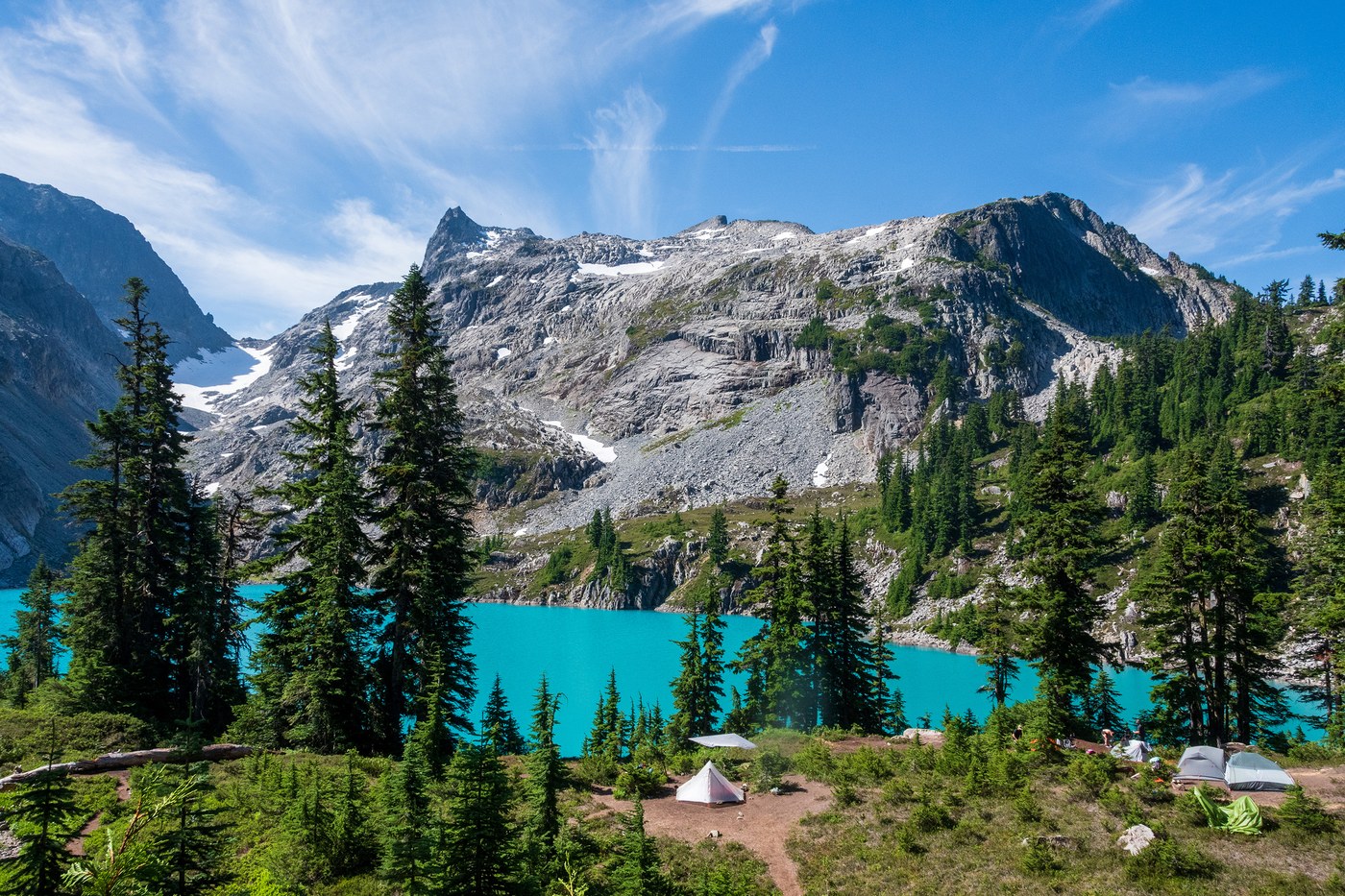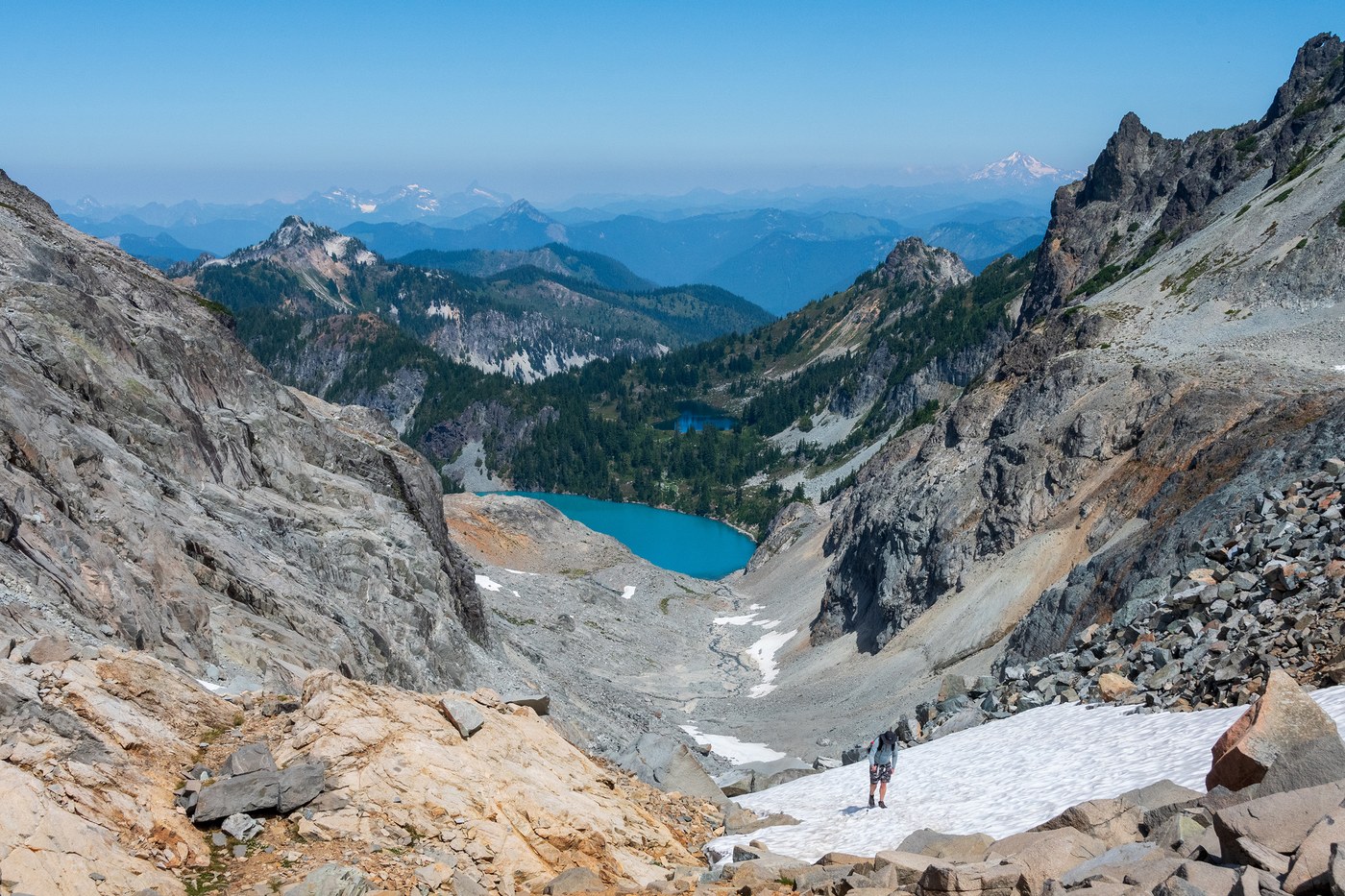Trying to dodge wildfire smoke and excessive heat, our group of three settled on Marmot Lake as a relatively close and low-key option for our annual multi-day backpack. We left on Friday morning and after the dusty trip up NF-4330 from Salmon La Sac, we rolled into the Tucquala Meadows trailhead a little after 10. The parking areas were already filling up but we were able to snag one of the last spots. The outhouse there apparently had no TP and was quite unpleasant, so you might want to plan ahead :)
The short trail segment to Hyas Lake is unremarkable except for some of the densest and tastiest huckleberries around. We may come back just to pick! Passing Hyas, you’ll hit a few muddy spots and one puncheon bridge in the process of being rebuilt, but they’re easily navigated. The climb up to Deception Pass was tougher than I remembered, but being two weeks out from a case of Covid might have had something to do with it. Black flies were increasingly pesky and were only somewhat deterred by picaridin.
The grade gets milder after you pass the turnoff to Tuck and Robin Lakes, and pretty soon you hit the PCT – stay on it for all of about 200 feet before turning left onto the Marmot Lake trail. It continues climbing gently, crossing several streams and passing small tarns before descending again into a cliff-walled basin. The increasing heat and humidity were not welcome on the last push out of the stream valley, and some folks were struggling on the sun-exposed switchbacks through a brushy avalanche slope. Fortunately, the grade moderates and the trail runs back into forest for most of the last mile to Marmot, although mosquitoes and horseflies joined the black flies on this stretch. The trail runs by a pretty waterfall shortly before the (unsigned until after you pass it) trail fork; bear left/uphill for Marmot and right/level for Clarice.
Marmot is a good-sized lake with a good-sized camping area, but apparently it’s no match for its popularity – none of us had ever been to such a busy backcountry campground before. Don’t expect to have a spot for yourself, especially on or near a weekend. There were two, three, or even four tents to a site and larger parties were having to break up to find spots. Unfortunately, one group decided to camp on a sensitive meadow very near the toilet, which is bad form on multiple levels. Hopefully the Forest Service will post some signage to discourage this. Other than that and one unnecessarily loud early-morning departure that woke up dozens of other campers, people were friendly and observing good etiquette. We enjoyed chatting with folks from BC, Oregon, California, and even Florida as well as locals.
For this cold-water wuss, Marmot Lake was just swimmable and refreshing after the hot hike up. On the other hand, the bugs were awful – not the worst I’ve had (Lyman Lake takes that honor), but probably top three, and the mosquitoes were more than happy to bite through layers. I was kicking myself for not bringing permethrin-treated clothing. Almost everyone was chased into their tents around twilight when they became especially unbearable.
The day hike up to Jade and Dip Top Gap is a must-do and not as strenuous as I expected. The short stretch around Marmot is actually among the rougher parts of the trail, with steep rooty slopes and a few blow-downs to clamber over. Navigating the talus chutes was no big deal going up, especially given how busy the trail was, but look for cairns if you get turned around. Before long, you’ll climb into the lovely alpine meadows between Marmot and Jade. No Name Lake is surprisingly pretty and there’s a nice campsite at the far end that was empty when we came through.
However, Jade Lake is clearly the star of the show here – a liquid jewel of unearthly turquoise surrounded by dramatic cliffs that could hold its own with anything in the Canadian Rockies, and patches of wildflowers only add to the scenery score. It's one of the most gorgeous alpine lakes I’ve ever seen. But don’t expect solitude here either, as all the campsites we saw were occupied.
Bear left for the informal route to Dip Top, which climbs steadily past more campsites before making a short but steep and loose descent back to the lake – poles are very helpful here. The rest of the ascent to the gap is straightforward, with several routes up the valley, and we did not bring or need spikes on the snowfield. The view of Pea Soup Lake, Mt. Daniel and its Lynch Glacier is stunning and the bugs were much reduced up there. We stopped at the gap, but others were continuing down to Pea Soup, and one brave guy was even swimming in the glacier-fed water.
Some folks were glissading down the snowfield, but as I didn’t bring anything to slide on, I opted to plunge-step and it passed quickly. The rest of the descent was uneventful except that the unstable talus slopes take a lot more attention on the way down, and I also got a hornet sting in the woods about a half-mile out from Marmot. They were buzzing around something right on the trail in a steep section of tree roots – not sure whether it was a dead animal or other food or someone kicked into a nest, since I was past it by the time I was stung and hustled on to prevent another. Luckily it only hurt for a few minutes, but those with allergies will want to take care.
We’d planned for three nights at Marmot, but since we’d done the main day hike and were tiring of the ravenous bugs, we opted to break camp on Sunday morning and head for Lake Clarice. This short trail is obviously much less used, as it quickly gets brushy in places after the turn-off. The lake itself is pretty enough, but not as dramatic as Marmot or Jade, and there’s no obvious easy access given the shoreline is consistently steep and rocky. We also saw just a couple of small and shadeless campsites, although the bugs were maybe a little better. It wasn’t compelling enough to stay another night, so we headed down a day ahead of schedule.
We passed a good number of groups heading up and many of the Hyas Lake campsites were occupied. Unfortunately, we also caught a whiff of campfire smoke passing Hyas Lake. Please note there is a burn ban in effect for the entire Mt. Baker-Snoqualmie National Forest given the dangerously dry conditions across the region. The last thing first responders need to deal with is yet another wildfire, especially in such a busy area.







Comments